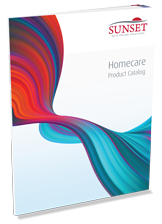How they work and how to select the best products for your client.
Pulse oximetry is a non-invasive method for monitoring the oxygen saturation levels (SpO2) in your patients’ blood. SpO2 is the percentage of oxygen that blood carries compared to the maximum it is capable of carrying. A normal rate is 94-99% in adults. Patients with COPD or other lung diseases generally have blood oxygen levels of 92% or lower, causing them to require supplemental oxygen treatment.
When is a pulse oximeter used?
In general, pulse oximeters are used to provide insight into the functioning of the patient’s respiratory system. It can be used anytime these levels need to be tested or diagnosed.
In the senior care and homecare setting, a portable pulse oximeter like the one shown above is most commonly used to treat or diagnose patients with respiratory diseases that cause low levels of oxygen in their blood when they breathe air. A pulse oximeter is an easy, non-invasive way to measure oxygen levels at any time so supplemental oxygen amounts can be adjusted as needed throughout the day.
In addition, different types of pulse oximeters are also commonly used in the hospital setting, often during surgery with anesthesia or in the recovery room. They are also used in sleep labs as a part of sleep apnea diagnosis. In a non-medical setting, pilots and athletes commonly require spot checks at high altitudes or during rigorous training.
How do pulse oximeters work?
Generally, pulse oximeters work by shining two different kinds of light (red and infrared) through a thin part of a patient’s body, usually a fingertip or earlobe. Blood absorbs light differently depending on the level of oxygen it contains: oxygenated blood absorbs more infrared light than red light. So by comparing the changes in amounts of red and infrared light received, the instrument can calculate the SpO2 reading.
As a side benefit, you can also check your pulse, as the increase in the amount of blood with each heartbeat also affects the light.
Is a prescription required for pulse oximeters?
It depends on the device and how it’s being used. According to the FDA, if an oximeter is accurate enough to diagnose or treat a disease, a prescription is generally required. If not, a prescription may not be needed. For example, if an athlete or rockclimber wanted to monitor their pulse and oxygen levels, they could purchase an OTC model that is not intended for diagnosis and would not require a prescription. To be sure, ask the manufacturer where you purchased the device.
What type of pulse oximeter does my client need?
There are three common types that fit a variety of needs. The most common is the portable fingertip pulse oximeter, which is often used at home. It is relatively inexpensive, lightweight and easy to use. However, it doesn’t always provide an accurate reading for those with circulatory problems. Also, it is designed for spot checks, instead of continuous monitoring so there are also several other options available.
The handheld pulse oximeter is most commonly used in hospitals and has a clip and wire attached to a handheld monitor. It can be clipped to a finger, earlobe or toe in an emergency situation and can be used for spot checks or continuous monitoring. The monitor can record the patient’s information for several hours at a time. Many models also come with a built-in alarm that sounds if the patient’s SpO2 or pulse rate goes outside a designated range. Some also include the ability to connect directly to a printer to prevent documentation errors.
The final type is a wrist pulse oximeter that has a small fingertip sensor that is attached to a wristwatch style recording system that continuously monitors the blood oxygen saturation level and pulse rate. It is ideal for monitoring daily activities or for an overnight sleep study because it allows the freedom to perform daily tasks and has a memory that can last for several days at a time.


